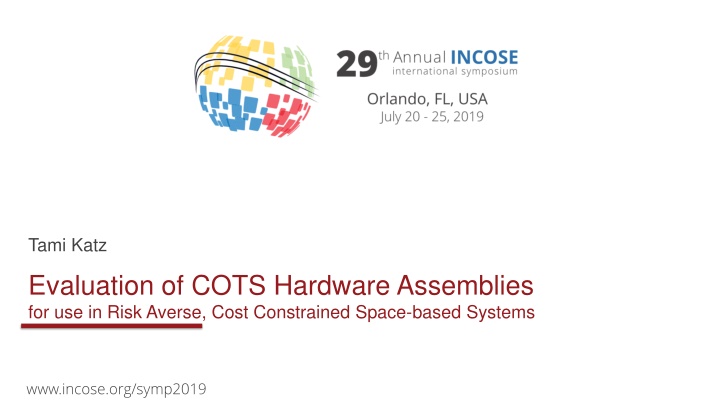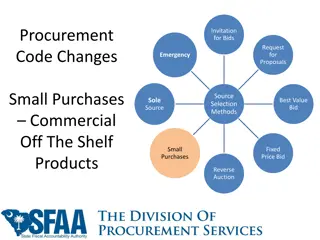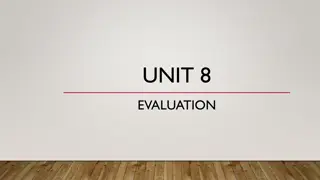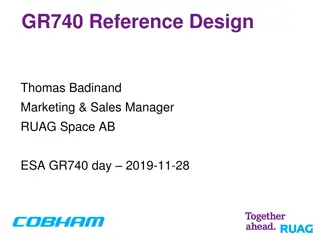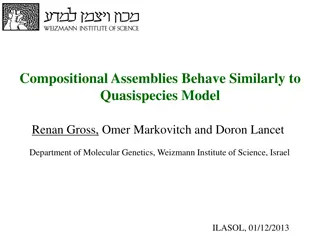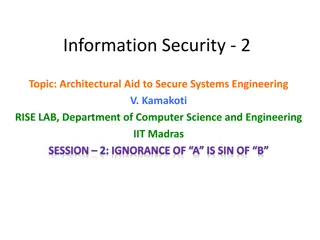Evaluation of COTS Hardware Assemblies for Space-based Systems
This content delves into the evaluation of Commercial Off-the-Shelf (COTS) hardware assemblies for risk-averse, cost-constrained space-based systems. It covers challenges, frameworks, examples, lessons learned, and the aerospace challenges of using COTS in government-funded programs. Additionally, it explores the importance of assessing existing products versus developing new ones, the benefits of COTS usage in saving costs and time, and the differences between a commercial and government approach in utilizing COTS. The text also discusses the lack of complete assessment frameworks for COTS hardware assemblies.
Download Presentation

Please find below an Image/Link to download the presentation.
The content on the website is provided AS IS for your information and personal use only. It may not be sold, licensed, or shared on other websites without obtaining consent from the author.If you encounter any issues during the download, it is possible that the publisher has removed the file from their server.
You are allowed to download the files provided on this website for personal or commercial use, subject to the condition that they are used lawfully. All files are the property of their respective owners.
The content on the website is provided AS IS for your information and personal use only. It may not be sold, licensed, or shared on other websites without obtaining consent from the author.
E N D
Presentation Transcript
Tami Katz Evaluation of COTS Hardware Assemblies for use in Risk Averse, Cost Constrained Space-based Systems www.incose.org/symp2019
Overview Introduction to COTS Challenges associated with COTS usage Framework for evaluating usage of COTS Example evaluation Lessons learned www.incose.org/symp2019 2
What is COTS? COTS = Commercial Off the Shelf Comes in many forms Software Assemblies Small components (fasteners, rivets, resistors) http://aegispower.co m/index.php/main https://bluecanyontech.com/stati c/datasheet/BCT_DataSheet_C omponents_StarTrackers.pdf http://www.criterialabs.com/pems -rf-parts-upscreening-to-nasa- eee-inst-002-l1-l2/ https://wpo- altertechnology.com/cots- commercial-off-shelf/ Scope of this paper is COTS Assemblies https://www.slideshare.net/Josi ahRenaudin/testing-in-the-new- world-of-offtheshelf-software https://militaryethernet.com/products/ www.incose.org/symp2019 3
Why use COTS? During the architecture and design definition phase a project may assess use of existing products against effort of developing a new product. This is part of a make vs. buy trade, where the buy is an existing product (COTS) compared to paying a company to develop the product. Usage of COTS can save on development costs and schedule. Determination of COTS benefit is typically done with a trade that leverages heritage of the product and supplier. Stakeholder Needs Stakeholder Requirements Stakeholder Validation System Requirements System Verification Subsystem Requirements Subsystem Verification Unit/Component Requirements Unit/Component Verification Typical level for COTS Assembly determination 4
Aerospace Challenges of Using COTS Aerospace space-based systems can vary! Government funded programs often have a risk averse customer that expects specific documentation for verification of the products being provided. New industry trends have utilized a more commercial approach with traditionally risk averse customers (DoD, NASA, other ), some of these still expect specific verification documentation based on safety concerns. Example: NASA s Commercial Crew Program Challenges exist when the customer still expects the high amount of verification documentation on a commercial program, particularly as COTS products are limited in available data. Fixed-Price Commercial Approach: Risk Tolerant Efficient and flexible approaches Minimal process oversight Minimal evidence required for verification and validation Cost-Plus Government Approach: Risk Averse Traditional approaches Significant Minimal process oversight Significant evidence required for verification and validation Challenges between Commercial approach with a Government Customer 5
Existing COTS Evaluation Processes Prior to implementing this effort research was conducted to find existing processes which could be used to guide a program team in evaluation of COTS assemblies. None of the existing frameworks provided a complete assessment and ability to show verification records for COTS hardware assemblies. Existing COTS Evaluation Framework Evaluation Process Overndorf, et al, An Activity Framework for COTS-Based Systems [1] Discussed that the usage of COTS is an act of reconciliation identifying what is wanted and comparing with what is available. Ferris, et al, The Impact of Understanding the Need and Available Products in COTS Selection [2] Addressed issues associated with the selection of COTS assemblies, recommending parameters of interest for use in evaluating the potential of COTS subsystems. Albert, et al, Evolutionary Process for Integrating COTS- Based Systems (EPIC): An Overview [3] Presented a method to evaluate software COTS using the COTS in the final software solution and assessing results. Carney, et al, Identifying Commercial Off-the-Shelf (COTS) Product Risks: The COTS Usage Risk Evaluation [4] Presented a method to evaluate software COTS by addressing the stakeholder s needs and ensuring the resultant usage was assessed against the needs. www.incose.org/symp2019 6
Proposed COTS Evaluation Approach Identify Project Requirements and Constraints Establish COTS criteria Checklist Obtain Data for COTS product and supplier A proposed approach has been generated that leverages prior research and allows for customization by a project. Results of this approach include documented risk mitigations and records useable in product verification. Obtain the project objectives, requirements associated to the COTS assembly Generate a project-specific checklist to evaluate the COTS assembly and supplier Use the checklist to obtain the necessary data for the COTS assembly and supplier Proceed with Recommendation on COTS Usage? N Analyze to Determine Gaps Perform Risk Assessment and Document Results Obtain other design solution Assess the checklist and COTS data to determine gaps to requirements or verification evidence for the COTS assembly Assess the gaps for risk to project; develop mitigation plans to address risks; document the results for the COTS assembly Y Obtain Project and Stakeholder Approval for COTS Usage Provide Documentation as Evidence to support Verification Provide recommendation to project management and stakeholders to use COTS with associated risks and mitigation plans Provide the assessment documentation and associated approval, along with any mitigation plan results, as evidence for the COTS assembly verification against program requirements www.incose.org/symp2019 7
COTS Evaluation Approach Steps 1. 2. 3. 4. 5. 6. Identify Project Requirements and Constraints Create criteria for the project (checklist) Obtain Data for COTS product and supplier Analyze to Determine Gaps Perform Risk Assessment and Document Results Make Decision on Whether to Proceed with Recommendation of COTS Usage Obtain Project and Stakeholder Approval for COTS Usage Provide Documentation as Evidence to support Verification 7. 8. www.incose.org/symp2019 8
Step 1 Identify Requirements / Constraints Many parameters needed by the COTS item can be collected summarized by the systems engineers, including: Performance parameters and Functions needed Operational Environments Non-functional design and quality requirements Mission assurance process requirements Additionally, constraints may exist for both technical (interfaces) and programmatic (risk posture, reliability, safety criticality) which can also be provided. The project team collects this information to be used as a basis for risk assessments and understanding of expected verification data required for the product (formats can vary) Systems Engineering Performance Parameters Functions Envirornments Design standards www.incose.org/symp2019 9
Step 2 Develop a COTS Evaluation Checklist Once the project requirements and constraints are identified, a checklist of specific parameters can be developed (example shown on next slide). This checklist is an aid for evaluation of different COTS solutions to address specific criteria for the project. Subject areas to consider for the checklist include (but not limited to): design data (performance, environments, part and material data, Interfaces) heritage of use fabrication processes test program and data security vulnerability plans for product upgrade or obsolescence past product failures post-delivery support for product www.incose.org/symp2019 10
Example Checklist The checklist includes the assessment of critical parameters needed to ensure the COTS satisfies program requirements Because this checklist simplifies the resultant verification data it will likely need to be agreed-to with customer and other program stakeholders prior to usage www.incose.org/symp2019 11
Step 3 Obtain COTS Data Assessment of the COTS solution uses information about the COTS assembly and the COTS supplier themselves. COTS suppliers typically provide datasheets for public usage. Conversations with the suppliers may also yield additional data, and in some cases the supplier may be willing to support providing data towards the evaluation checklist. For some suppliers this is additional scope; they may either not provide this information, or provide at a substantial increase in cost. Any missing data is a risk and assessed accordingly. COTS Available Data Test Results Material List Heritage Overview www.incose.org/symp2019 12
Step 4 Analyze to Determine Gaps The project team compares the requirements and constraints against the COTS data to identify any gaps. Areas where the COTS product is either not meeting the project criteria, or the data is missing, are identified. For identified gaps, a trace to customer requirements identifies whether the customer will need to be included in any subsequent approvals towards the COTS usage. Program Need COTS Available Data Evaluating Team Gap? Test Results Material List Heritage Overview www.incose.org/symp2019 13
Step 5 Perform Risk Assessment and Document the Results The project team performs a risk assessment for the parameters that do not meet the project requirements or processes. For the identified gaps, evaluations of mitigation options assess if the gaps can be reduced using techniques such as: system design solutions by the project (isolators, etc.) additional qualification tests by the supplier or project additional analyses or inspections The results are captured into a report for the COTS assembly that shows the assessment of the COTS assembly against the requirements and any identified risks and mitigation plans. The amount of effort put into this assessment is a function of the risk profile of the project. Evaluating Team Provide results of checklist Identify gaps to requirements Document any recommendations to close gaps (ex. recommend addition of Qualification Vibration Test) www.incose.org/symp2019 14
Step 6 Recommendation of COTS Usage The project technical team determines if the COTS assembly is a fit for the project, forming a recommendation whether to proceed with the COTS. This consists of a trade study to ensure all parameters are evaluated against other options (e.g. developing a custom assembly, subcontracting with a supplier for unit development, or purchasing a different COTS product). Decision to proceed will lead to a more formal program acceptance of the product. Evaluating Team Proceed with Recommendation on COTS Usage? N Obtain other design solution Y Obtain Program Approval www.incose.org/symp2019 15
Step 7 Obtain Project and Stakeholder Approval for COTS Usage Approval for the decision to use COTS will depend on the project, but at a minimum involves personnel with authority to accept any residual project risk or costs associated with the mitigation plans, such as a program review board. For projects with risk averse customers that require insight or oversight this may go to a customer review board for formal acceptance to ensure resultant verification evidence or requirement gaps are accepted. www.incose.org/symp2019 16
Step 8 Provide Documentation as Verification Evidence Upon approval for usage of the COTS assembly, the assessment report serves as record for the evaluation effort for the COTS hardware assembly usage. This report, along with evidence obtained from any mitigation plans, serves as the verification evidence for the COTS assembly against the project requirements. Stakeholder Validation System Verification Subsystem Verification Unit/Component Verification www.incose.org/symp2019 17
Example Evaluation An example of the application of the COTS framework is shown through evaluation of a specific set of material and process (M&P) requirements on a project. Systems Engineer Systems Engineer Responsible Engineer M&P Engineer Identifies non-mission critical classification Identifies NASA-STD-6016 M&P requirements needed Adds need for material list to COTS checklist Reviews Material List to assess for prohibited items, flammability, off-gassing, outgassing, compatibility with application of use Discusses risks with customer counterpart Provides recommendation of compliance and risk Obtains material list from COTS supplier The resultant effort would reduce a 200 requirement standard to a material list request and evaluation of a handful of parameters by a subject matter expert. Systems Engineer M&P Engineer Program Team Customer Team Evaluating Team Provides assessment report and MUA as verification towards NASA-STD-6016 requirement Obtains and documents the M&P recommendation Identifies gap to full verification of all NASA-STD-6016 requirements Collects assessments on other requirement topics Recommends COTS usage to program and customer Generates Material Usage Agreement with Customer for COTS materials Agrees to COTS Usage www.incose.org/symp2019 18
Lessons Learned While applying this to the author s program a few items were observed: The engineering staff required training to understand the concept of meeting intent of requirements and addressing associated risk, this was a new paradigm for them as they were previously conditioned to ensure every individual requirement shows verification evidence. The checklist needed a few iterations to ensure it was complete and singular; time was spent after the first few evaluations to adjust the checklist for use on subsequent evaluation efforts. Systems engineering needed to identify and communicate the full program list of COTS assemblies and their evaluation process (became an SE oversight function). Safety and Mission Criticality of the COTS assemblies is a key factor in the evaluation. COTS piece-part and COTS assemblies can vary in what evaluation process and which stakeholder approval is required; Having both types of processes defined and communicated was key to addressing this confusion. www.incose.org/symp2019 19
References 1. Overndorf, T, Brownsword, L, Sledge, CA 2000, An Activity Framework for COTS-Based Systems, CMU/SEI-2000-TR- 010 addressed the 2. Ferris, TLJ, Do, Q 2010, The Impact of Understanding the Need and Available Products in COTS Selection, INCOSE IS 2010 3. Albert, C, Brownsword, L 2002, Evolutionary Process for Integrating COTS-Based Systems (EPIC): An Overview 4. Carney, DJ, Morris, EJ, Place PRH 2003, Identifying Commercial Off-the-Shelf (COTS) Product Risks: The COTS Usage Risk Evaluation, CMU/SEI-2003-TR-023 www.incose.org/symp2019 20
